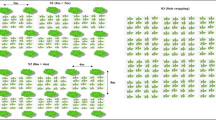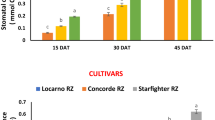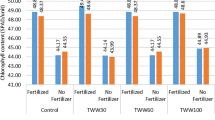Abstract
Olive trees are grown under high evaporative demand and less precipitations that are variable in time and space especially in semi-arid conditions. The objective of this work is to determine the most efficient water treatment applied in an olive field (Olea europaea L. cv Chemlali) from the 98th to the 294th Julian day, in Tunisian semi-arid conditions. The choice of this time frame was done to control the effect of irrigation on the trees behavior in the irrigation period of the year (from April to October) and determine the most sensitive phenological stages to irrigation. For this reasons, two water treatments were applied: T100% (irrigation at 100% of Available Water Content (AWC)) and T50% (irrigation at 50% AWC). The results show that, according to leaf water potential, carbon isotope discrimination, and olive production parameters, the T50% AWC water treatment is the most efficient. The leaf water potential of the two water treatments applied has not exceeded −2.5 MPa during the whole experiment which indicates that the trees of the two water treatments were not stressed. The T50% AWC shows a water use efficiency of 5.18 g/l compared to 2.93 g/l for T100% water treatment. This result demonstrate that Chemlali cultivar valorizes better low quantities of water rather than high quantities, so saving 50% of water resources applied will ensure the sustainability of water resources and stability of olive production.





Similar content being viewed by others
References
d’Andria R, Lavini A, Morelli G, Sebastiani L, Tognetti R (2008) Physiological and productive responses of Olea europaea L. cultivars Frantoio and Leccino to a regulated deficit irrigation regime. Plant Biosystems 143:222–231
Ben Mariem, S. (2013). Estimation et contrôle des besoins en eau de l’olivier (Olea europaea L. cv Meski) conduit en intensif. Projet de Fin d’Etudes. Institut Supérieur Agronomique de Chott Mariem. 115 p
Braham, M. (1997). Activité écophysiologique, état nutritif et croissance de l’olivier (Olea europaea L.) soumis à une contrainte hydrique, thèse d’État, faculté des sciences agronomiques de Gand, Belgique. 160 p
Caruso G, Rapoport HF, Gucci R (2013) Long-term evaluation of yield components of young olive trees during the onset of fruit production under different irrigation regimes. Irrig Sci 31:37–47
Dbara S, Haworth M, Emiliani G, Mimoun MB, Gómez-Cadenas A, Centritto M (2016) Partial Root-Zone Drying of Olive (Olea europaea var.'Chetoui') Induces Reduced Yield under Field Conditions. PloS one 11(6):e0157089
Diaz-Espejo A, Buckley TN, Sperry JS, Cuevas MV, De Cires A, Elsayed-Farag S, Rubio-Casal AE (2012) Steps toward an improvement in process-based models of water use by fruit trees: a case study in olive. Agric Water Manag 114:37–49
FAO, I (2014). WFP (2014). The state of food insecurity in the world, 12
Farquhar GD, Richards RA (1984) Isotopic composition of plant carbon correlates with water-use efficiency of wheat genotypes. Funct Plant Biol 11(6):539–552
Fernandez JE (2014) Understanding olive adaptation to abiotic stresses as a tool to increase crop performance. Environ Exp Bot 103(2014):158–179
Galán C, García-Mozo H, Vázquez L, Ruiz L, Díaz De La Guardia C, Domínguez-Vilches E (2008) Modeling olive crop yield in Andalusia, Spain. Agron J 100(1):98–104
Goldhamer DA, Dunai J, Ferguson LF, Lavee S, Klein I (1994) Irrigation requirements of olive trees and responses to sustained deficit irrigation. Acta Hort 356:172–175
Gucci R, Lodolini EM, Rapoport HF (2007) Productivity of olive trees with different water status and crop load. J Hortic Sci Biotechnol 82(4):648–656
Intergovernmental Panel on Climate Change. (2014). Climate change 2014–impacts, adaptation and vulnerability: Regional Aspects. Cambridge University Press
Hijazi A, Doghoze M, Jouni N, Nangia V, Karrou T, Oweis T (2014) Water requirement and water use efficiency for olive trees under different irrigation systems. In: 7th International Conference on Water Resources in the Mediterranean Basin, October, 10–12 2014. Morocco, Marrakech
Lodolini EM, Polverigiani S, Ali S, Mutawea M, Qutub M, Pierini F, Neri D (2016) Effect of complementary irrigation on yield components and alternate bearing of a traditional olive orchard in semi-arid conditions. Span J Agric Res 14(2):1203
Pastor, M., Orgaz, F., Vega, V., Hidalgo, J., Castro, J., 1998. Programación de riego. In: Junta de Andalucia (Ed.), Informaciones Técnicas. , pp. 11–32
Patumi M, d’Andria R, Fontanazza G, Morelli G, Giorio P, Sorrentino G (1999) Yield and oil quality of intensively trained trees of three cultivars of olive (Olea europaea L.) under different irrigation regimes. J Hortic Sci Biotechnol 74(6):729–737
Podgronik M, Bandelj D (2015) Deficit irrigation principles applied to olive orchard in Slovene Istria. Acta agriculturae Slovenica 105(2):337–344
Quiroga S, Iglesias A (2009) A comparison of the climate risks of cereal, citrus, grapevine and olive production in Spain. Agric Syst 101(1):91–100
Turner NC (1981) Techniques and experimental approaches for the measurement of plant water status. Plant Soil 58:339–366
United Nations, Educational, Scientific and Cultural Organization UNESCO. 2009. UNESCO World Water Assessment Programme. http://www.unesco.org/new/ en/natural ciences/environment/water/wwap/
Acknowledgments
The authors acknowledge all the Olive Tree Institute (Unit of Sousse, Tunisia) technical staff for the help and support that they gave us during the whole realization period of this research. Also, our acknowledgments are to the members of the research group “Plant Biology in Mediterranean Conditions” of the Balearic Islands University (Spain).
Author information
Authors and Affiliations
Corresponding author
Additional information
This article is part of the Topical Collection on Water Resource Management for Sustainable Development
Rights and permissions
About this article
Cite this article
Ben Hassine, M., Boussadia, O., Ben Abdelkader, A. et al. Water use efficiency of olive tree under two water treatments in Tunisian semi-arid conditions. Arab J Geosci 10, 302 (2017). https://doi.org/10.1007/s12517-017-3088-8
Received:
Accepted:
Published:
DOI: https://doi.org/10.1007/s12517-017-3088-8




